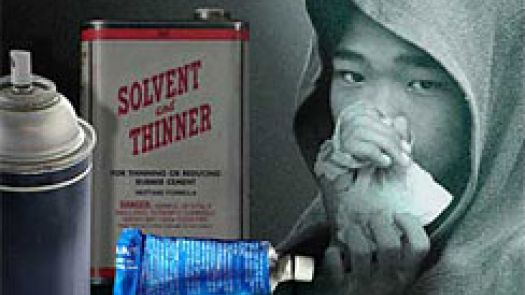Inhalant Abuse
 Treatment
Treatment
The term “inhalants” applies to a range of products (most of which are common in households across
the United States) that can be abused in order to achieve a state of disorientation or euphoria.
Inhalants are most commonly abused by adolescents and teenagers, though adults have also been known to engage in inhalant abuse.
The following are among the more commonly abused inhalants:
Model glue
Nail polish remover
Gasoline
Spray paint
Cooking spray
Correction fluid (such as Liquid Paper and Wite-Out)
Cleaning fluids
Chemicals in commonly abused inhalants include butane, propane, fluorocarbons, ethyl chloride, acetone, and nitrous oxide.
Inhalant Abuse
Inhalant abuse usually occurs via “huffing” — that is, inhaling the fumes from the substances. For the inhalant abuser to get maximum effect from the substance being abused, the substances may be poured into a plastic bag or soaked into a rag, which is then placed very near the nose and mouth.
Inhalant abuse leads to intense short-term effects, including the following:
Slurred speech
Coordination problems
Cognitive distortion
Disorientation and confusion
Dizziness
Lightheadedness
Nausea
The effects of inhalant abuse are usually felt within seconds of the huffing, and generally dissipate within a matter of minutes. Of course, extended or chronic huffing or inhalant abuse can result in the following forms of long-term damage:
Brain damage
Liver and kidney damage
Memory loss
Seizures and spasms
Vision and hearing damage
Treatment for Inhalant Abuse
Treatment for inhalant abuse depends upon several factors, including the age and gender of the patient, the length and severity of the patient’s drug problems, the type(s) of inhalants being abused, the abuse of or addition to any other substances, and the presence of any co-occurring disorders.
Treatment for young people who have been involved in inhalant abuse may be done on an outpatient, residential, or partial hospitalization basis. Therapeutic boarding schools, therapeutic wilderness programs, and residential drug addiction recovery programs all offer effective treatment options for young people who have been abusing inhalants.
Treatment for inhalant abuse or addiction may include the following therapies and techniques:
Individual therapy
Group therapy
Family therapy
12-Step education
Relapse-prevention instruction
Cognitive Behavioral Therapy (CBT)
Dialectical Behavioral Therapy (DBT)
Biofeedback & Neurofeedback
Recreation therapy
Click Here for crchealth.com/addiction/inhalant-abuse-treatment
